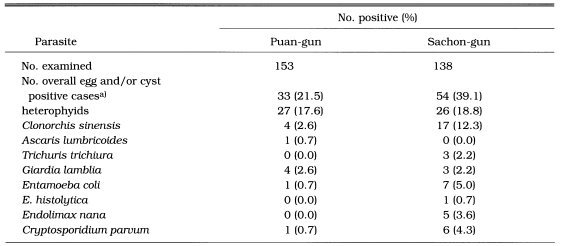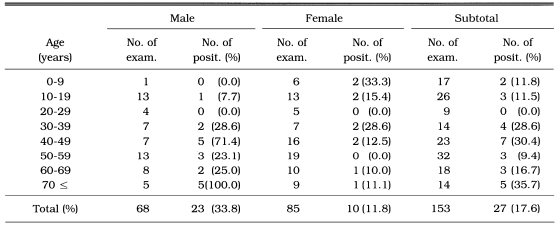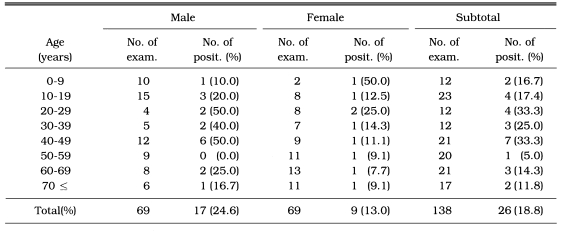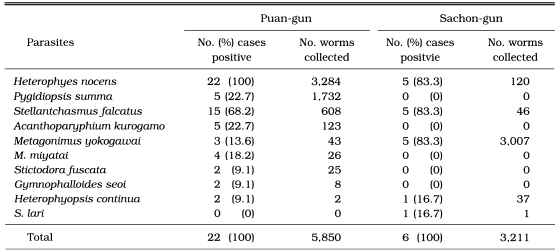Abstract
Two endemic foci of heterophyid infections were discovered in coastal villages of Puan-gun, Chollabuk-do, and Sachon-gun. Kyongsangnam-do, Korea. Fecal examinations were performed on 153 inhabitants of Puan-gun and 138 of Sachon-gun, using cellophane thick smear and formalin-ether sedimentation technique. The helminth egg and/or protozoan cyst positive rate was 21.5% (33/153) in Puan-gun and 39.1% (54/138) in Sachon-gun. In Puan-gun, the egg positive rate of heterophyids was the highest, 17.6%, and that of other parasites was 0.7-2.6% by parasite species. In Sachon-gun, that of heterophyids was 18.8%, followed by Clonorchis sinensis (12.3%), and other parasites (0.7-5.0%). Twenth-two (Puan-gun) and six (Sachon-gun) heterophyid egg positive cases were treated with praziquantel, and adult flukes were collected from their diarrheic stools. A total of 3,284 adult flukes of Heterophyes nocens was collected from all of the 22 patients treated in Puan-gun (3-778 individually), and other trematodes were also collected from 2-15 patients: Pygidiopsis summa, Stellantchasmus falcalus, Metagonimus yokogawai, M. miyatai, Stictodora fuscata, Heterophyopsis continua, Acanthoparyphium kurogamo, and Gymnophalloides seoi. In Sachon-gun, M. yokogawai (3,007 specimens), H. nocens (120), and S. falcatus (46) were collected from 5 of 6 treated patients, and H. continua and S. lari each from one patient. The present study revealed that heterophyid flukes, especially H. nocens and M. yokogawai, are prevalent in the southern and western coastal areas of Korea where fresh and/or brackish water fishes are popularly eaten raw.
Keywords: heterophyids, Heterophyes nocens, Heterophyopsis continua, Pygidiopsis summa, Stellantchasmus falcatus, Stictodora fuscata, S. lari, Acantho-paryphium kurogamo, Gymnophalloides seoi
INTRODUCTION
A recent national survey revealed a remarkable decrease in the prevalence of intestinal parasites, owing to successful control activities of the government and an improved socioeconomic status of Korean people (Ministry of Health and Welfare and Korea Association of Heaith; MHW and KAH, 1997). Soil-transmitted nematodes such as Ascaris lumbricoides, Trichuris trichiura and hookworms are, therefore, no more public health problems. However, intestinal trematode infections are still highly prevalent in rural areas, and epidemiological studies have shown that heterophyids and echinostomes prevail in the eastern and southern coastal areas (Chai and Lee, 1990). Recently, a new human intestinal trematode, Gymnophalloides seoi, has been found to be prevalent in inhabitants of southwestern islands, who enjoy eating raw oysters (Lee et al., 1994). These together indicate that food-borne parasitic infections are prevalent in a significant number of population in Korea.
The egg positive rate of Metagonimus yokogawai, a major intestinal trematode in Korea, was 0.3% nationwidely, and 0.2% in urban and 0.6% in rural areas (MHW and KAH, 1997). However, the national survey does not reflect the real situation of intestinal trematode infections especially in rural and coastal areas. Therefore, local epidemiological studies on intestinal trematodes are highly necessitated for proper understanding of the current status of human infections and for the provision of control strategies. In the present study, two coastal villages in Kyehwa-myon, Puan-gun, Chollabuk-do, and in Sanam-myon, Sachon-gun, Kyongsangnam-do, were investigated for heterophyid fluke infections and has been proven to be endemic foci of heteophyids and other intestinal fluke infections.
MATERIALS AND METHODS
Two coastal villages in Kyehwa-myon, Puan-gun, Chollabuk-do and in Sanam-myon, Sachon-gun, Kyongsangnam-do (Fig. 1) were subjected to an epidemiological survey for intestinal parasitic infections from November 1996 to February 1997. Fecal samples were collected from 153 (Puan-gun) and 138 (Sachon-gun) inhabitants, and examined by both cellophane thick smear and formalin-ether sedimentation technique.
Fig. 1.
Map showing two surveyed areas at the southwestern (Puan-gun, Chollabuk-do) and southern (Sachon-gun, Kyongsangnam-do) coastal areas.
After the fecal examination, 22 (Puan-gun) and 6 (Sachon-gun) heterophyid egg positive cases were treated orally with a single dose of praziquantel, 10 mg/kg, and purged with 30 g of magnesium sulfate. After 1 hr, the whole diarrheic stools were collected individually and washed several times with tap water. The sediment was fixed with 1% formalin, and transferred to our laboratory. The flukes were collected under a stereomicroscope, flattened gently under a cover slip pressure, and fixed with 10% neutral buffered formalin. They were stained with Semichon's acetocarmine for species identification. Statistical significance of positive rates between males and females was analysed by the Student's t-test
RESULTS
The overall helminth egg and/or protozoan cyst positive rate was 21.5% (33/153) in Puan-gun, and 39.1% (54/138) in Sachon-gun (Table 1). Six (18.2%) people in Puan-gun and 20 (14.5%) in Sachon-gun were infected with more than two kinds of parasites, the major of which was heterophyid flukes. The egg positive rate of trematodes, composed of various species of heterophyids and Clonorchis sinensis, was the highest in both surveyed areas, 20.3% (31/153) in Puan-gun and 31.2% (43/138) in Sachon-gun, respectively. Other parasites showing positive rates were A. lumbricoides, Giardia lamblia, Entamoeba coli, and Cryptosporidium parvum in Puan-gun, and T. trichiura, E. coli, C. parvum, Endolimax nana, G. lamblia, and . histolytica in Sachon-gun (Table 1).
Table 1.
Prevalence of egg and/or cyst positive rate by fecal examination among the inhabitants of two coastal areas (Puan-gun, Chollabuk-do and Sachon-gun, Kyongsangnam-do)
a)Mixed infections with 2-4 kinds of parasites were found in 6 cases (Puan-gun) and 20 cases (Sachon-gun).
In Puan-gun, the highest egg positive rate (35.7%) for heterophyids was observed in the age group of over 70 years, followed by the forties and the thirties (Table 2). In Sachon-gun, the forties and the twenties showed the highest egg positive rate (33.3%), followed by the thirties (Table 3). The positive rate between males and females was not significantly different in the two surveyed areas (p>0.05).
Table 2.
Distribution of heterophyid egg positive cases by age and sex of inhabitants in Puan-gun, Chollabuk-do
Table 3.
Distribution of heterophyid egg positive cases by age and sex of inhabitants in Sachon-gun, Kyongsangnam-do
Twenty-two egg positive cases of heterophyid flukes in Puan-gun and 6 cases in Sachon-gun were cooperative for collection of adult flukes after treatment with praziquantel and purgation. In Puan-gun, a total of 3,284 (average 149.3, range 3-778) adult H. nocens was collected from all the treated cases (Table 4). Other flukes collected were Pygidiopsis summa, Stellantchasmus falcatus, Acanthoparyphium kurogamo, M. yokogawai, M. miyatai, Stictodora fuscata, Heterophyopsis continua, and G. seoi (Table 4). In Sachon-gun, a total of 3,007 (average 501.2, range 2-2,801) M. yokogawai was collected from five treated cases, and other heterophyids collected were H. nocens, H. continua, S. falcatus, and S. lari. Mixed infections with 2-5 kinds of heterophyids were observed in 19 (Puan-gun) and 5 cases (Sachon-gun). The major species of the collected flukes was H, nocens in Puan-gun and M. yokogawai in Sachon-gun (Table 4).
Table 4.
Number of flukes collected from heterophyid egg positive cases after praziquantel treatment in Two areas
DISCUSSION
In the present study, two coastal villages were proven to be endemic for various species of heterophyid infections. The infection rate of inhabitants by heterophyids was comparatively lower in both surveyed areas than that of Muan-gun (75.0%) and Shinan-gun (42.9%) (Chai et al., 1994 & 1997). However, the worm burden was higher in Sachon-gun than in Muan-gun and Shinan-gun. After praziquantel treatment, 7 species of heterophyids, one species of echinostome and one species of gymnophallid were recovered from 22 patients of Puan-gun, and 5 species of heterophyids were collected from 6 cases of Sachon-gun. The major fluke collected was H. nocens in Puan-gun and M. yokogawai in Sachon-gun. From the results, it is speculated that heterophyid infections are highly prevalent along the coastal areas. Much attention should be paid to routine stool examinations of the inhabitants in the seashore villages.
The age-prevalence of intestinal parasites showed a relatively even pattern, although it revealed an aggregation tendency in individuals over 30 years of age in both males and females. However, the infection rate was very low in the twenties in Puan-gun and in the fifties in both surveyed areas, most family members of which were free from parasite infection, indicating a close relationship of heterophyid infections to their eating habits. It was reported that brackish water fishes such as the mullet (Mugil cephalus) or goby (Acanthogobius flavimanus) harbor the metacercariae of heterophyids and are sources of human infection (Chai and Lee, 1990). The inhabitants of both surveyed areas enjoyed eating raw flesh of mullets and gobies caught in estuaries near the villages.
Heterophyes nocens infection have been reported sporadically in Korea up until 1990 (Chai, 1996), and Shinan-gun (Chai et al., 1994), which is also an endemic focus of G. seoi infection (Lee et al., 1994), and Muan-gun, Chollanam-do (Chai et al., 1997) were reported as endemic areas. In the present study, a coastal village in Puan-gun is regarded as an endemic focus. It is highly suspected that Sachon-gun is also an endemic area of H. nocens infection, judged from the egg positive rate of heterophyids (18.8%), even though worm burden of the infected cases was low.
Metagonimus yokogawai infection has been prevalent along the eastern and southern coastal areas and in islands, where the sweetfish, Plecoglossus altioelis, are available (Seo et al., 1981; Song et al., 1985). Metagonimus yokogawai was the most frequent species among the collected flukes in Sachon-gun in this study. Therefore, it is suggested that this area is an endemic focus of metagonimiasis, although the exact figure was difficult to draw due to mixed infections with other heterophyids.
A total of 123 A. kurogamo, an intestinal trematode of seashore birds belonging to the family Echinostomatidae, was first recovered from humans in the present study. The adult worms revealed several distinct morphological characteristics; a single row of 23 spines on head collar lacking grouped ventral corner spines, the cirrus sac passing beyond the posterior edge of the ventral sucker, and vitellaria extending to the level of the cirrus sac, occasionally only to the level of the entire testes (Yamaguti, 1939). Biological studies on the intermediate host of A. kurogamo are now under way to find the possible sources of human infection and to determine whether the human infections were accidental or not. The details of human infections and biological data on A. kurogamo will be published elsewhere.
The present study is also the first account in the literatures of human infection with S. lari. However, only one specimen of S. lari was recovered from a patient of Sachon-gun, where metacercariae of S. lari have been found in the head of gobies caught from a stream at Sachon-gun in 1987 (Chai et al., 1989). The first description of human infection with S. lari will be also published elsewhere.
As for S. fuscata, the present study adds two more cases from patients of Puan-gun, which become the 6th and 7th cases in Korea (Chai et al., 1997). Human infections with S. falcatus were reported in 4 cases so far (Chai and Lee, 1990). This study adds a total of 20 confirmed cases from 15 patients of Puan-gun and 5 of Sachon-gun. In regard to H. continua, three cases, two in Puan-gun and one in Sachon-gun, become the 6th-8th cases of human infection (Chai et al., 1997). Five human infections by P. summa were confirmed in Puan-gun, which is near to Okku-gun, Chollabuk-do, the known endemic area (Seo et al., 1981).
Two cases of G. seoi infection were found in Puan-gun. This area is very close to Byonsan-myon, where the oysters were found to be infected with G. seoi metacercariae, although the infection rate was very low (Lee et al., 1996). However, the cases recalled that they ate raw oysters while working at a saltern in a distant area, Paeksu-myon, Yonggwang-gun, Chollanam-do, where the oysters were reported to be negative for G. seoi metacercariae (Lee et al., 1996). Thus, this area is suspected to be a minor endemic area of G. seoi infection, and an epidemiologic study should be done in the future.
The practical method of preventing human infections by intestinal flukes is to curtail eating raw or improperly cooked or salted brackish water fishes in endemic areas. The difficulty of detecting and treating human carriers and enforcing sanitary measures or destroying the snail hosts renders general control measures impracticable. Since heterophyid infection is sporadic and its endemicity is variable, it seems to be more effective that the control measure is driven by the provincial governments.
References
- 1.Chai JY. Parasitic zoonoses in Korea trematode infections. Proceed VIIIth Int'l Cong Parasitol. 1996;20(suppl. 1):359–366. [Google Scholar]
- 2.Chai JY, Kim IM, Seo M, et al. A new endemic focus of Heterophyes nocens, Pygidiopsis summa, and other intestinal flukes in a coastal area of Muan-gun, Chollanam-do. Korean J Parasitol. 1997;35(4):233–238. doi: 10.3347/kjp.1997.35.4.233. [DOI] [PubMed] [Google Scholar]
- 3.Chai JY, Lee SH. Intestinal trematodes of humans in Korea: Metagonimus, heterophyids and echinostomes. Korean J Parasitol. 1990;28(suppl):103–122. doi: 10.3347/kjp.1990.28.suppl.103. [DOI] [PubMed] [Google Scholar]
- 4.Chai JY, Nam HK, Kook J, Lee SH. The first discovery of an endemic focus of Heterophyes nocens (Heterophyidae) infection in Korea. Korean J Parasitol. 1994;32(3):157–162. doi: 10.3347/kjp.1994.32.3.157. [DOI] [PubMed] [Google Scholar]
- 5.Chai JY, Park SK, Hong SJ, Choi MH, Lee SH. Identification of Stictodora lari (Heterophyidae) metacercariae encysted in the brackish water fish, Acanthogobius flavimanus. Korean J Parasitol. 1989;27(4):253–259. doi: 10.3347/kjp.1989.27.4.253. [DOI] [PubMed] [Google Scholar]
- 6.Chai JY, Sohn WM. Identification of Stellantchasmus falcatus metacercariae encysted in mullets in Korea. Korean J Parasitol. 1988;26(1):65–68. doi: 10.3347/kjp.1988.26.1.65. [DOI] [PubMed] [Google Scholar]
- 7.Ministry of Health and Social Welfare, Korea Association of Health. Prevalence of intestinal parasitic infections in Korea - The sixth report - Seoul, Korea: 1997. (Monograph series in Korean) [Google Scholar]
- 8.Lee SH, Chai JY, Lee HJ, et al. High prevalence of Gymnophalloides seoi infection in a village on a southwestern island of the Republic of Korea. Am J Trop Med Hyg. 1994;51:281–285. doi: 10.4269/ajtmh.1994.51.281. [DOI] [PubMed] [Google Scholar]
- 9.Lee SH, Sohn WM, Hong SJ, et al. A nationwide survey of naturally produced oysters for infection with Gymnophalloides seoi metacercariae. Korean J Parasitol. 1996;34(2):107–112. doi: 10.3347/kjp.1996.34.2.107. [DOI] [PubMed] [Google Scholar]
- 10.Seo BS, Lee SH, Cho SY, et al. An epidemiologic study on clonorchiasis and metagonimiasis in riverside areas in Korea. Korean J Parasitol. 1981;19(2):137–150. doi: 10.3347/kjp.1981.19.2.137. [DOI] [PubMed] [Google Scholar]
- 11.Sohn WM, Han GG, Kho WG, Chai JY, Lee SH. Infection status with the metacercariae of heterophyid flukes in the brackish-water fish from Haenam-gun, Chollanam-do, Korea. Korean J Parasitol. 1994;32(3):163–169. doi: 10.3347/kjp.1994.32.3.163. [DOI] [PubMed] [Google Scholar]
- 12.Song CY, Lee SH, Jeon SR. Studies on the intestinal fluke, Metagonimus yokogawai Katsurada, 1912 in Korea IV. Geographical distribution of sweetflsh and infection status with Metagonimus metacercaria in southeastern area of Korea. Korean J Parasitol. 1985;23(1):123–138. doi: 10.3347/kjp.1985.23.1.123. [DOI] [PubMed] [Google Scholar]
- 13.Yamaguti S. Studies on the helminth fauna of Japan, trematodes of birds, IV. Jap J Zool. 1939;8(2):131–210. [Google Scholar]
- 14.Yu SH, Mott KE. Epidemiology and morbidity of food-bome intestinal trematode infections. Trop Dis Bull. 1994;9(7):R126–R146. [Google Scholar]







